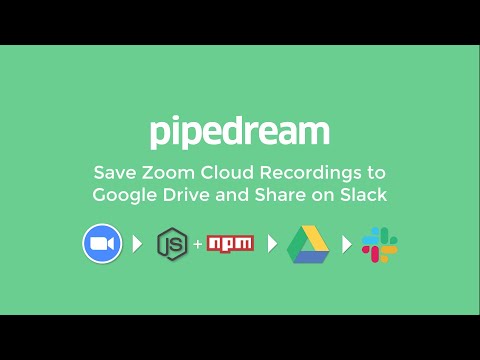What do you want to automate with Zoom?
Prompt, edit and deploy AI agents that connect to Zoom and 3,000+ other apps in seconds.
1-24of3,000+apps by most popular
Trusted by 1,000,000+ developers from startups to Fortune 500 companies
Overview#
The Zoom API lets you tap into a rich set of functionalities to enhance the video conferencing experience within your own app or workflow. With the Zoom API on Pipedream, you can automatically create meetings, manage users, send meeting notifications, and more, orchestrating these actions within a broader automation. This allows for seamless integration with other services, enabling both data collection and action triggers based on Zoom events.
Pipedream workflows allow you to run any Node.js code that connects to the Zoom API. Just create a new workflow, then add prebuilt Zoom actions (create a meeting, send a chat message, etc.) or write your own code. These workflows can be triggered by HTTP requests, timers, email, or on any app-based event (new tweets, a GitHub PR, Zoom events, etc).
import { axios } from "@pipedream/platform"
export default defineComponent({
props: {
zoom: {
type: "app",
app: "zoom",
}
},
async run({steps, $}) {
return await axios($, {
url: `https://api.zoom.us/v2/users/me`,
headers: {
Authorization: `Bearer ${this.zoom.$auth.oauth_access_token}`,
},
})
},
})
Example Use Cases#
Automated Meeting Scheduling and Notifications: With Pipedream, you can create a workflow that listens for upcoming calendar events in Google Calendar. Once it detects a new event labeled "Zoom Meeting," it can trigger the Zoom API to create a meeting and then automatically send custom email notifications with the meeting details to all the attendees using SendGrid.
Zoom Webinar Attendee Management: Build a workflow where new sign-ups from an event management platform like Eventbrite trigger the addition of these attendees to a Zoom webinar. Post-webinar, send a follow-up email via Mailgun with a link to the webinar recording, which you can upload to a cloud storage platform like Dropbox.
Meeting Analytics and Reporting: Combine Zoom's meeting ended webhook with Pipedream's capabilities to create a workflow that captures meeting details upon conclusion. With this data, you can send a summary email to the host, update a Google Sheet with attendance information, and even push the data to a BI tool like Tableau for more in-depth analysis.
Getting Started#
- First, sign up for Pipedream at https://pipedream.com.
- Visit https://pipedream.com/accounts.
- Click the button labeled Click Here to Connect an App.
- Search for "Zoom" and select either Zoom or Zoom Admin (see the differences below):
This will open up a new window prompting you to authorize Pipedream's access to your Zoom account. Once you authorize access, you should see your Zoom account listed among your apps.
- Create a new workflow, add a new step, search for "Zoom" or "Zoom Admin". Once you've selected either app, you can choose to either "Run Node.js code" or select one of the prebuilt actions for performing common API operations.
- At this stage, you'll be asked to link the Zoom account you connected above, authorizing the request to the Zoom API with your credentials.
Zoom vs Zoom Admin app
Zoom users can be classified into two groups: non-admins and admins. Admins have account-level permissions that users do not, and Zoom has corresponding admin-level scopes that aren't relevant for normal users. Therefore, Pipedream exposes two apps — Zoom and Zoom Admin — to serve the two groups.
In the Zoom Marketplace, these apps are named Pipedream, and Pipedream for Zoom Admins, respectively.
Non-admins have permissions to manage standard Zoom resources in their account: meetings, webinars, recordings, and more. If you're a non-admin, you'll want to use the Zoom app.
Zoom admins have permissions to manage account-level resources, like users and reports. They can also manage webinars and meetings across their organization. If you're an admin and need to manage these resources via API, you'll want to use the Zoom Admin app.
The Zoom API docs on permissions provide detailed information on these permissions and their associated OAuth scopes.
Popular Zoom Integrations#
Popular Zoom Triggers#
Emit new event each time a meeting is created where you're the host
Emit new event each time a meeting starts where you're the host
Emit new event each time a new recording completes for a meeting or webinar where you're the host
Emit new event each time a meeting ends where you're the host
Emit new event each time a meeting is updated where you're the host
Popular Zoom Actions#
Authentication#
Name Slug: zoomZoom uses OAuth authentication. When you connect your Zoom account, Pipedream will open a popup window where you can sign into Zoom and grant Pipedream permission to connect to your account. Pipedream securely stores and automatically refreshes the OAuth tokens so you can easily authenticate any Zoom API.
Pipedream requests the following authorization scopes when you connect your account:
- authorization
GEThttps://zoom.us/oauth/authorize?client_id={{oauth.client_id}}&redirect_uri={{oauth.redirect_uri}}&state={{oauth.state}}&response_type=code&scope={{oauth.space_separated_scopes}} - accessToken
POSThttps://zoom.us/oauth/tokencontent-type:application/x-www-form-urlencodedaccept:application/jsonredirect_uri={{oauth.redirect_uri}}&grant_type=authorization_code&code={{oauth.code}} - refreshToken
POSThttps://zoom.us/oauth/tokencontent-type:application/x-www-form-urlencodedaccept:application/jsongrant_type=refresh_token&refresh_token={{oauth.refresh_token}}
Related Videos#
